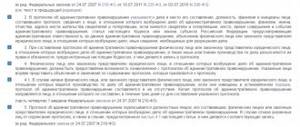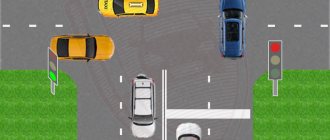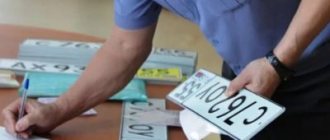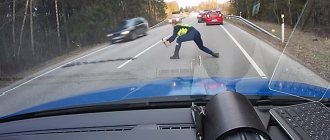Should a road protocol be drawn up at all?
Yes. But with one important subtlety that applies in 2021, and due to a recent change in the law, not many drivers are aware of it. This is due to the change in Article 28.6 of the Code of Administrative Offenses in 2014. And today, in any case, a ruling on the case is being made.
To help you understand the terminology in car law:
- a protocol is simply a list of circumstances of an administrative case and it initiates proceedings in the case (it is just beginning and open),
- a ruling is a decision already made in a case in the form of a fine, deprivation of rights or other punishment; Once the decision is made, the case is closed.
Changes when drawing up the protocol
| As it was? | How is 2021? |
| 1. When a violation was detected, the inspector always drew up a protocol. | 1. The traffic police inspector can immediately make a decision on the violation case. |
| 2. If the driver does not agree with the protocol, then the case is referred to the traffic police for further consideration. | 2. If the driver disputes the violation, then after the decision is made, a protocol is drawn up (Part 2 of Article 28.6 of the Administrative Code). |
| 3. During the investigation, the traffic police either makes a decision against the driver in question, or the case is terminated, and the driver is thus declared innocent. | 3. Since the decision has already been made, the driver can only appeal it in the prescribed manner. |
Thus, the protocol for today is just a formality, a document that is drawn up for the driver to further appeal the fine or to transfer the case to court.
Cases of mandatory submission of explanations
Article 26.3 of the Code of Administrative Offenses of the Russian Federation provides for cases of mandatory submission of explanations in a case of an administrative offense.
Thus, a medical/pharmaceutical organization in respect of which proceedings are being conducted in a case of an administrative offense, provide explanations included in the protocol on the administrative offense, in the protocol on ensuring measures and the protocol on consideration of the case.
https://www.youtube.com/watch?v=https:accounts.google.comServiceLogin
Typically, such explanations are given during the very initiation or consideration of a case - when the organization (its representative) does not have the opportunity to thoroughly consider certain circumstances relevant to the case. Accordingly, such explanations can be used both in favor of the organization and against it.
Please note that at the stage of considering a case of an administrative offense, hearing explanations given by the organization is also a mandatory procedure (Part 2 of Article 29.7 of the Code of Administrative Offenses of the Russian Federation).
However, in this article we would like to talk about explanations in a case of an administrative offense that can be presented by an organization independently, on its own initiative, not because it is required by law.
As is known, in administrative proceedings there is a presumption of innocence of the person against whom proceedings for an administrative offense are being conducted: this means that if a case for an administrative offense is initiated against an organization, it is considered innocent until its guilt will be proven in the manner prescribed by the Code of Administrative Offenses of the Russian Federation, and established by a decision of the judge, body, or official who considered the case that has entered into legal force.
At the same time, the organization in respect of which proceedings are being conducted in a case of an administrative offense, like no one else, is interested in proving its innocence and can use for this the mechanism of presenting explanations in a case of an administrative offense if it does not agree with the protocol issued against it. administrative offense.
Such explanations are prepared by the organization as a separate document and presented to the person considering the case (a judge or an official of a supervisory authority) in order to influence its outcome.
Is it possible and how to appeal the protocol?
The protocol is not subject to appeal . Since the driver is not directly found guilty of the act by the protocol. But what to do then? The decision makes the motorist guilty, and it is this decision that is subject to further challenge to the head of the traffic police in whose territory it was issued, or to the court.
But, as we have already explained above, the traffic police inspector is obliged to draw it up so that you indicate that you do not agree with the alleged violation, and also indicate the circumstances of the case. If the policeman refuses to draw it up, then you can indicate your disagreement in a direct resolution anywhere. In this case, also indicate the employee’s refusal to write a protocol.
You will also be interested in:
- Is it possible to recover moral damages for an appealed fine or arrest and how?
- Suspension from driving a vehicle in questions and answers
- The road repairs have been completed, but the temporary signs have not been removed - is the fine legal?
We write “disagree” correctly
Every citizen, even a violator, has every right to disagree with the information specified in the protocol. However, the wording must be correct. The banal phrase “I disagree” will clearly not be enough. Do the following:
- Turn the protocol over and look for the column “Explanation of the violator.”
- Change the word "offender" to "driver." This way you will express disagreement with the information provided, since you do not consider yourself a “violator”.
- Next, clearly state all your thoughts and opinions about the situation.
- Explain that the traffic police officer drew up the protocol “biased.”
- If you have certain knowledge in the field of traffic rules, be sure to indicate a specific point or article.
Only after filling out the entire explanation can you correct the second word in the paragraph “signature of the violator” to “driver” and sign the document. It should also be noted that the driver was not fully explained his rights.
If a traffic police officer tries to show aggression or behaves inappropriately, these important circumstances must be mentioned.
On a note! If the inspector behaves aggressively, all his actions should be recorded on a phone camera. In this case, you need to warn the police officer that his actions are being recorded. The recording can be strong evidence of the driver’s innocence in court.
If an accident occurs, the traffic police officer will have to draw up two reports - an original and a copy. The second copy must be handed over to the driver. If this norm is not observed, it is necessary to indicate the fact of violation in the original document.
Do I need to sign the protocol?
Yes. If you do not agree with the protocol (more precisely, with the violation, as we found out above), then in any case it is not advisable to refuse to sign it. Simply put, your reluctance to put an “autograph” on a document will lead to nothing in principle - in this case, the inspector will write on it that you refused to sign, and it will be valid.
The right approach
If you do not agree with the points of the protocol on committing an administrative offense, it is necessary to correctly formalize the refusal to sign it from the legal side.
Attention! Please note the following points:
- in the completed protocol, in each place where the term “violator” is written, write the word “driver.” There is no need to cross out anything. Just write a different term on top with a pen. This will help reflect disagreement that you have committed an administrative offense;
- In the Explanations section, express your point of view eloquently. The fact of a violation when drawing up an administrative protocol by a traffic police officer must be indicated here. It is worth referring to each incorrect point and justifying it from the point of view of the law;
- if there are witnesses to the commission of a violation when filling out the protocol by a traffic police officer, it is necessary to indicate this in the explanation. You can attach an explanation with a personal signature and date of compilation on a separate sheet;
- in the “I have read the protocol” section, it is necessary to reflect information about whether the traffic police officer explained the rights and obligations of the violator. It should also be indicated here how he acted during the preparation of the protocol;
- make sure that no field is left blank. If there is nothing to write, you should cross the line with a straight line or the letter “Z”. Some unscrupulous servants of the people take advantage of this and insert information that neither the driver nor the witnesses were familiar with, which affects the decision;
- If an accident occurs, then compliance with the registration procedure is mandatory. If this is not done, the fact is reflected in the protocol;
- the protocol is drawn up in two copies. The first part, filled in with a pen, remains with the traffic police officer, the second is given to the driver.
Interested persons, for example, relatives of the offender or other traffic police officers performing their direct duties at this time, cannot be involved as witnesses and witnesses.
Remember! When reporting an accident, you need to pay attention to the following points:
- it is mandatory to draw up a diagram of the road traffic accident;
- the diagram is drawn directly at the scene of the accident;
- the diagram is drawn up with an exact indication of the distance between the cars involved in the accident, as well as reflecting other small details.
If the driver does not consider himself a violator, he has the right not to sign the protocol, however, it is very important to reflect his opinion in the “Explanations” paragraph. This will help you defend your rights in court.
If you don’t agree with the violation, what should you write?
So write:
“I don’t agree with the violation charged to me. The help of a defender is required."
And sign the protocol.
Where to write disagreement? Such an entry must be made in a special column with explanations from the person held accountable. The traffic police report has an approved form, and this field is on its reverse side. Here:
Thus, if you do not agree with the violation, then you need to make 2 entries in the protocol (or resolution - it doesn’t even matter much):
- directly write: “I do not agree with the violation,”
- put your signature.
I do not agree with the protocol of the traffic police officer
I do not agree with the protocol of the traffic police officer
Any motorist may disagree with the protocol drawn up by a traffic police officer. This is clear to everyone. However, the correct procedure for a car enthusiast is not known to all car enthusiasts.
Today we will talk about the rights that are granted to the driver by the Code of Administrative Offenses of the Russian Federation (CAO RF). After all, it is this law that regulates the procedure for drawing up protocols, considering a case, and appealing a decision.
By using your rights wisely, a motorist will be able to appeal an unfair charge of violating traffic rules.
Procedure for drawing up protocols by a traffic police officer
Giving explanations to a traffic police officer
Firstly, in accordance with Article 25.1 of the Code of Administrative Offenses of the Russian Federation, the driver can give an explanation to the traffic police officer. To give or not to give an explanation to a traffic police officer (on the merits of an allegedly committed violation) is the right, not the responsibility of the driver. After all, in accordance with Article 51 of the Constitution of the Russian Federation, no one can be forced to testify against themselves.
Thus, when and in what form to give an explanation is a decision that the car enthusiast himself must make. Some motorists write in the protocols “I do not agree!”, and some give a more detailed explanation: “I did not violate the traffic rules, the driver violated such and such, who performed such and such a maneuver, one hundred witnesses can confirm their full name...”.
More detailed explanations can help the motorist challenge the protocol drawn up by the traffic police officer. However, car enthusiasts who plan to go into detailed explanations should understand that any vaguely formulated thought can lead them to Calvary. You need to choose your words very carefully when writing your explanations. You should not use words whose meaning is not completely clear to you. Also, you should not believe various tips that various “well-wishers” may “whisper in your ear.” You need to think for yourself.
Some motorists pay attention to the fact that in the protocol on an administrative offense (it is in this protocol that the explanation is usually written) there is very little space for writing a detailed explanation.
What to do if the car enthusiast could not fit his explanations into the “explanation...” column?
You shouldn't put up with this state of affairs. Just ask the traffic police officer for a paper (survey, explanation, etc.) so that you can complete your explanation.
The rationale for such a request is as follows: The legislator has granted the driver the right to give explanations, which means that the traffic police officer is obliged to ensure that the driver exercises this right (if the driver has a desire to give an explanation).
Well, this is of course in theory. But in practice, it is best to have pieces of paper with you. In this case, if the traffic police officer does not provide a survey form to give detailed explanations, you can write an explanation on your own sheets. It is also important to insure against the “loss” of such an explanation.
Familiarization with the case materials
Secondly, the driver has the right to familiarize himself with all the materials of the case. Every self-respecting motorist should at least once familiarize himself with the materials of the case, with the initiation of which he does not agree. You can find a lot of interesting things there.
It is very important that the legislator used the word “all” in Article 25.1 of the Code of Administrative Offenses (the driver can familiarize himself with the case materials). And there have been cases when drivers, under various pretexts, were not allowed to view the video recordings.
This is a gross violation of the motorist's rights if he is not given the case for review. Even causing partial obstacles (for example, they did not allow you to watch the video, saying that this can only be done in a court hearing) in familiarizing yourself with the case is a serious offense. After all, such an offense “pulls” other violations with it.
For example, how can a driver prepare to defend his rights at trial if he is not familiar with the evidence? No, a motorist cannot properly defend his rights without familiarizing himself with the case materials.
The reasons why the car enthusiast was not given the case for review are of no importance. There is no video player, someone took the case materials, there was a fire, etc. These are problems whose solution should not be left to the car enthusiast. The most important thing for the driver is to record the violations committed (refusal to provide the file for review).
What to do after reading the case materials? Submit requests and present evidence.
Application by the driver and presentation of evidence
So, the car enthusiast got acquainted with the case. Now he has all the information he needs. Or not?
Indeed, the case materials do not always contain all the information necessary to cancel the protocol. Often, in order to cancel an unfair traffic police protocol, the driver must provide new evidence. There are also cases when it is necessary to double-check “old” evidence (for example, it was obtained in violation of the law).
In such cases, the driver can file a petition. For example, a petition to call a witness, witness, specialist, expert. Petitions may also be submitted to request a checklist, location of road signs, etc. With the help of petitions, the driver can obtain new information that will lead to the cancellation of the illegal protocol.
Just don’t forget about the requirements of Article 24.4 of the Administrative Code for the procedure for filing petitions. Otherwise you can get into trouble.
Protocol - what kind of document?
The concept of this document is enshrined in the Code of Administrative Offenses of the Russian Federation. To put it in your own words, a protocol is an official document drawn up by an authorized official, containing information about the essence of the administrative offense. The specified document must indicate the circumstances of its commission, information about the culprit, witnesses, victims, and a specific article of the law regulating liability for the violation.
In everyday life, many people who do not have a specialized legal education often say: “appealing the protocol.” This statement is, of course, incorrect from the point of view of the law, since only a decision made based on the results of an examination of the evidence in the case, including the above-mentioned document, can be challenged.
The protocol serves only the role of recording the circumstances of a specific offense. That is why it is impossible to challenge the presence/absence of source data. In this case, the culprit has the right to file appropriate objections regarding the information contained therein. We’ll talk about how to do this further and consider a sample objection to a protocol on an administrative violation.
Exceptional circumstances
If one of the following initial data is present, then the case is not initiated, and the one started must be terminated at any stage:
- there is no event (for example, there was no actual accident, but the car was damaged as a result of a falling stone);
- there is no composition (there is no object/subject/objective/subjective side of the violation: the person is under 16 years of age);
- emergency situation (the accident was committed to prevent a collision with a pedestrian);
- act of amnesty on release from punishment;
- termination of the law regulating liability for violation;
- the statute of limitations has expired;
- if there is already an act issued on the fact of the violation or a criminal case has been initiated;
- death of the culprit individual/bankruptcy of a legal entity;
- others.
https://www.youtube.com/watch?v=ytabout
I would like to note that the investigation of these cases is a difficult and time-consuming procedure. Whatever sample objection to a protocol on an administrative offense you find on the Internet, it is clear that it needs to be reworked to suit the specific circumstances of your case. If difficulties arise, it is always better to seek help from a professional lawyer.
Structure
So, objections to the protocol and a complaint against a decision on an administrative offense must be structured competently and logically. The text of these documents usually contains the following components:
- header: indication of the body/official to whom the paper is addressed; Full name and contact details of the person submitting it;
- main part: a link to the appealed document with its details, briefly the circumstances of the case, the essence of the offense, reasons for disagreement and arguments based on the law;
- pleading part: clear requirements in accordance with legal norms;
- attachment: additional documents (if necessary).
This does not mean that your document must strictly follow the above structure. Let’s say that objections to the protocol often lack a clear pleading part, since the general point of view of the guilty person is described.
A competent example of objections to a protocol on an administrative offense is given below.









